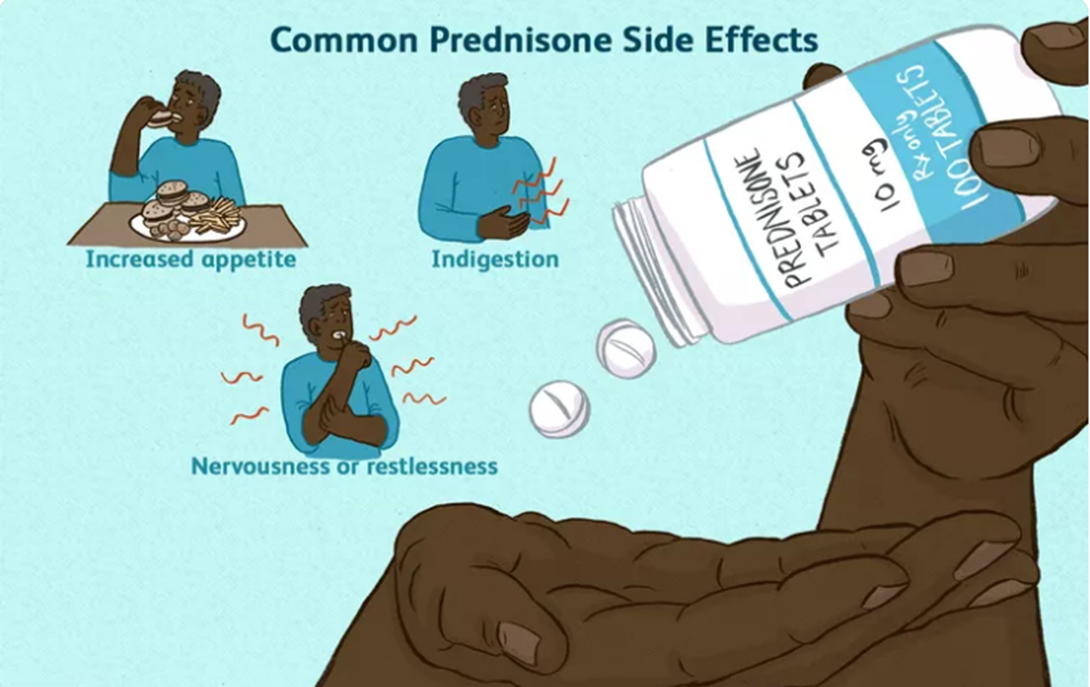A nurse is reviewing the medication list for a client who has a new diagnosis of type 2 diabetes mellitus. The nurse should recognize which of the following medications can cause glucose intolerance?
Dextromethorphan
Prednisone
Atorvastatin
Cimetidine
The Correct Answer is B
Choice A reason: Dextromethorphan is a cough suppressant that does not affect blood glucose levels. It is safe to use for clients with diabetes.
Choice B reason: Prednisone is a corticosteroid that can cause glucose intolerance by increasing glucose production and decreasing insulin sensitivity. It can worsen hyperglycemia and increase the risk of diabetic complications.
Choice C reason: Atorvastatin is a statin that lowers cholesterol levels and reduces the risk of cardiovascular disease. It does not cause glucose intolerance and may have a beneficial effect on glycemic control.
Choice D reason: Cimetidine is a histamine-2 receptor antagonist that reduces stomach acid production and treats ulcers and gastroesophageal reflux disease. It does not cause glucose intolerance and has no significant interaction with diabetes medications.

Nursing Test Bank
Naxlex Comprehensive Predictor Exams
Related Questions
Correct Answer is D
Explanation
Choice A reason: 0.2 tablets is not the correct answer. To convert mg to mcg, multiply by 1000. Therefore, 0.175 mg is equal to 175 mcg. To find the number of tablets, divide the dose by the amount available. Therefore, 175 mcg / 8 mcg = 21.875 tablets. Round this to the nearest whole number, which is 22 tablets.
Choice B reason: 2 tablets is not the correct answer. This is the result of dividing the dose by 100 instead of 1000, which is incorrect.
Choice C reason: 20 tablets is not the correct answer. This is the result of rounding down instead of up, which is incorrect.
Choice D reason: 22 tablets is the correct answer. This is the result of converting the dose to mcg, dividing by the amount available, and rounding to the nearest whole number.
Correct Answer is B
Explanation
Choice A reason: The client waits 10 min between inhalations is not the correct answer. This is not a recommended practice for using an albuterol inhaler. The client should wait at least 1 min between inhalations to allow the medication to reach the lungs and avoid overdose.
Choice B reason: The client takes a quick inhalation while releasing the medication from the inhaler is the correct answer. This is the correct way to use an albuterol inhaler. The client should breathe in quickly and deeply while pressing down on the inhaler to release the medication. This ensures that the medication is delivered to the airways and not the mouth or throat.
Choice C reason: The client exhales as the medication is released from the inhaler is not the correct answer. This is not a recommended practice for using an albuterol inhaler. The client should exhale before using the inhaler, not during or after. Exhaling while using the inhaler can cause the medication to be wasted or to irritate the mouth or throat.
Choice D reason: The client holds his breath for 10 seconds after inhaling the medication is not the correct answer. This is not a recommended practice for using an albuterol inhaler. The client should hold his breath for only a few seconds after inhaling the medication, not 10 seconds. Holding the breath for too long can cause dizziness, headache, or chest discomfort.
Whether you are a student looking to ace your exams or a practicing nurse seeking to enhance your expertise , our nursing education contents will empower you with the confidence and competence to make a difference in the lives of patients and become a respected leader in the healthcare field.
Visit Naxlex, invest in your future and unlock endless possibilities with our unparalleled nursing education contents today
Report Wrong Answer on the Current Question
Do you disagree with the answer? If yes, what is your expected answer? Explain.
Kindly be descriptive with the issue you are facing.
